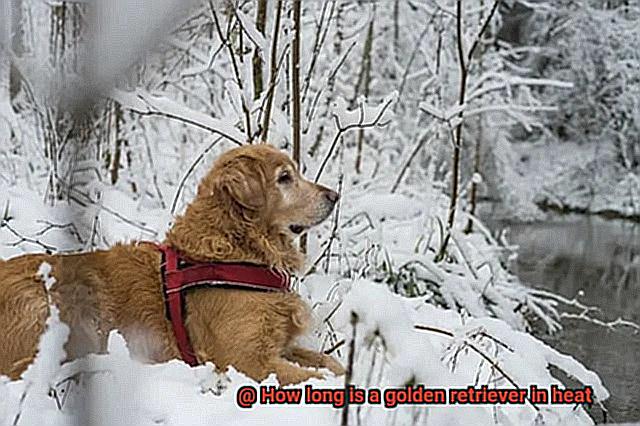Do you adore your golden retriever like they’re a part of your family? If the answer is yes, then you must be aware of their reproductive cycle to ensure their well-being and happiness. One of the most important phases in a female dog’s life is their heat cycle, which plays a crucial role in mating and reproduction. But how long does a golden retriever stay in heat?
Hold on tight because the answer may surprise you. Typically, a golden retriever stays in heat for approximately three weeks on average. However, this duration can vary slightly based on factors such as age, weight, and environmental stimuli. During this time, your furry friend might experience mood swings, lethargy, and sudden bursts of affectionate behavior. These symptoms are caused by hormonal changes that occur during the estrous cycle.
As a pet parent, it’s essential for you to be mindful of these changes and provide your golden retriever with adequate care and attention. Keeping track of their heat cycle can also help prevent unwanted pregnancies and ensure their overall reproductive health.
So if you’re curious to learn more about how to care for your furry companion during this period and how long a golden retriever stays in heat, then keep reading. This article will provide valuable insights into everything you need to know about your beloved pet’s heat cycle.
What is the Heat Cycle of a Golden Retriever?
Contents
This recurring event happens twice a year and is a vital part of their reproductive system. The heat cycle, also known as estrus, typically lasts for around 21 days, but each dog’s cycle can vary.
The heat cycle is marked by three distinct stages: proestrus, estrus, and diestrus. During the first stage, proestrus, which lasts about nine days, your dog’s body is preparing for ovulation and estrogen levels are rising. You may notice that your pup’s vulva is swollen and that she has a bloody discharge.
The second stage, estrus, lasts for about seven days and is when your female Golden Retriever is most receptive to mating. During this time, her discharge may become lighter in color. She may also display certain behaviors such as restlessness, increased urination, and a swollen vulva.
The final stage, diestrus, lasts for around three months. If a female doesn’t mate during estrus, her body will return to normal hormone levels and she will no longer be receptive to mating.
It’s important to keep in mind that during the heat cycle, female Golden Retrievers can attract male dogs from far and wide. Therefore, it’s crucial to ensure that your pet is kept in a safe and secure environment during this time to prevent unwanted breeding.
Spaying female Golden Retrievers can prevent unwanted pregnancies and reduce the risk of certain health issues later in life. Consult with your veterinarian if you have any concerns or questions about your pet’s heat cycle.
The Four Stages of the Heat Cycle
This cycle occurs twice a year and can last up to three weeks, but its duration may vary from dog to dog.

The first stage of the heat cycle is proestrus, lasting an average of 9 days. During this stage, your female dog’s body starts preparing for mating by producing high levels of estrogen. As a result, you may notice swelling in her vulva and a bloody discharge. She might also become more restless and agitated.
The second stage, estrus, lasts for 7-10 days and is when your female dog is most fertile and receptive to mating. The discharge may change from bloody to a lighter color, and the vulva will appear less swollen. Your furry friend may actively seek out male dogs and display mating behaviors such as flagging her tail.
The third stage of the heat cycle is diestrus, lasting 60-90 days if your dog doesn’t become pregnant. During this stage, your female’s hormone levels return to normal, and the vulva returns to its regular size. If she becomes pregnant, this stage lasts until the puppies are born.
Finally, there’s anestrus, the period of sexual inactivity between heat cycles that could last several months to a year.
It’s crucial to keep track of your golden retriever’s heat cycle to avoid unwanted breeding or plan for breeding if desired. During estrus, make sure to keep your female dog away from male dogs unless you intend to breed her.
Proestrus Stage
During this stage, your furry friend’s body prepares for potential mating by producing hormones that trigger the ovaries to release eggs. As a result, physical changes such as swelling of the vulva and an increase in vaginal discharge occur.
However, it’s important to remember that during proestrus, your female dog is not yet receptive to mating and may even be defensive or aggressive towards male dogs. As a responsible pet owner, it’s crucial to keep a close eye on her to prevent unwanted breeding and potential health risks such as uterine infections.
Apart from these physical changes, golden retrievers in the proestrus stage may experience mood swings, restlessness, and decreased appetite. So, providing plenty of comfort and affection during this time can help your dog feel secure and calm.
It’s worth noting that attempting to mate during proestrus is unlikely to result in pregnancy as the eggs have not yet fully matured. It’s best to wait for the estrus stage when your dog becomes receptive to mating.
Estrus Stage
This period, also known as the heat cycle, is a time when a female golden retriever is ready to breed and potentially become pregnant. The estrus stage typically lasts for 2-3 weeks, but can vary from dog to dog and occur twice a year with 6-month intervals.
During this stage, a female golden retriever’s body undergoes various changes. One of the most noticeable changes is that her vulva swells and she will have discharge. You may also observe behavior changes such as restlessness, vocalization, and mood swings. These modifications indicate that she is ready to mate, and male dogs may be attracted to her during this time.
It is important to note that during the early stages of estrus, your female golden retriever may not be receptive to mating. As the stage progresses, she becomes more receptive, but may become aggressive towards male dogs if she is not interested in breeding.
As a responsible pet owner, it’s essential to recognize the signs of the estrus stage in your female golden retriever and take appropriate measures to prevent unwanted breeding. This can involve keeping her indoors or supervised when around other dogs or using a dog diaper or sanitary pad to manage the discharge.

Diestrus Stage
The diestrus stage is the second part of this cycle, also known as the luteal phase, and lasts for around 60 to 90 days. During this time, the ovaries release progesterone, which prepares the uterus for pregnancy.
One of the most noticeable changes during this stage is your dog’s behavior. Your furry friend may become less interested in mating and more withdrawn. You may also notice a decrease in vaginal discharge and swelling of the vulva. However, it’s important to note that females can still get pregnant during this stage if they mate with an unneutered male dog. So, it’s essential to keep them away from any potential suitors.
Proper care during the diestrus stage is crucial for your golden retriever’s health and well-being. This includes providing them with enough exercise and a balanced diet. Regular veterinarian check-ups are also vital to ensure that your dog remains healthy throughout this phase.
Anestrus Stage
One of these phases is the anestrus stage – a period of rest that occurs between heat cycles.
During this time, your golden retriever won’t experience any visible signs of heat such as vaginal bleeding or swollen vulva. This can make them appear less active and interested in mating than they were during the previous estrus stage. However, don’t worry. It’s a natural and resting phase.
It’s important to note that the length of this stage can vary depending on various factors such as age, breed, and overall health of your golden retriever. Typically, this stage lasts for about 2-3 months but can last up to 6 months in some cases.
As a responsible pet owner, it’s crucial to keep a close eye on your furry friend’s reproductive cycle and seek veterinary advice if you have any concerns about their health or behavior throughout any stage of their cycle. During the anestrus stage, it’s also important to ensure that your golden retriever is receiving proper nutrition and exercise to maintain their overall health and well-being.
Conclusion
As a responsible pet owner, it’s crucial to be aware of your golden retriever’s reproductive cycle and the duration of their heat cycle. On average, a female golden retriever stays in heat for approximately three weeks, but this can vary based on factors such as age, weight, and environmental stimuli. During this time, your furry friend may experience mood swings, lethargy, and sudden bursts of affectionate behavior due to hormonal changes that occur during the estrous cycle.
To prevent unwanted pregnancies and ensure your dog’s overall reproductive health, keeping track of their heat cycle is essential. The heat cycle is marked by three distinct stages: proestrus, estrus, and diestrus. Each stage brings physical and behavioral changes that indicate your dog’s readiness for mating.
As a responsible pet owner, it’s vital to recognize these signs and take appropriate measures to prevent unwanted breeding. This can involve keeping them indoors or supervised when around other dogs or using a dog diaper or sanitary pad to manage the discharge.
Proper care during each stage of the heat cycle is crucial for your golden retriever’s health and well-being. Regular veterinarian check-ups are also important to ensure that your dog remains healthy throughout each phase of their reproductive cycle. By being mindful of your furry companion’s needs during this period and providing them with adequate care and attention, you can help ensure their happiness and well-being as an integral part of your family.
In summary, understanding how long a golden retriever is in heat is just one aspect of responsible pet ownership. By being attentive to their reproductive health needs and taking appropriate measures during each stage of the heat cycle, you can help ensure that your furry friend remains healthy and happy for years to come.









